Topic Last Modified: 2011-04-12
This procedure does not require membership in a local administrator or privileged domain group. You should log on to a computer as a standard user.
After you have defined your topology, use the following procedure to define a Front End pool for your site. For details about defining the topology, see Define and Configure a Topology in Topology Builder.
 To define a Front End pool
To define a Front End pool
-
In the Define New Front End Pool Wizard, on the Define the New Front End pool page, click Next.
-
On the Define the Front End pool FQDN page, enter a fully qualified domain name (FQDN) for the pool you are creating, click Enterprise Edition Front End Pool, and then click Next.
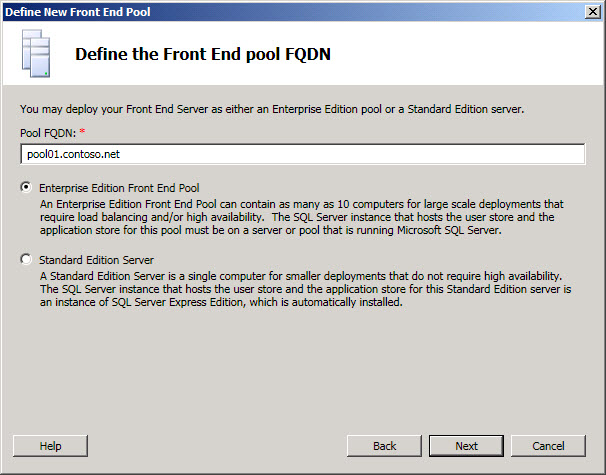
-
On the Define the computers in this pool page, enter a computer FQDN for the first Front End Server in the pool, and then click Add. Repeat this step for any additional computers (up to ten) that you want to add to the pool, and then click Next.
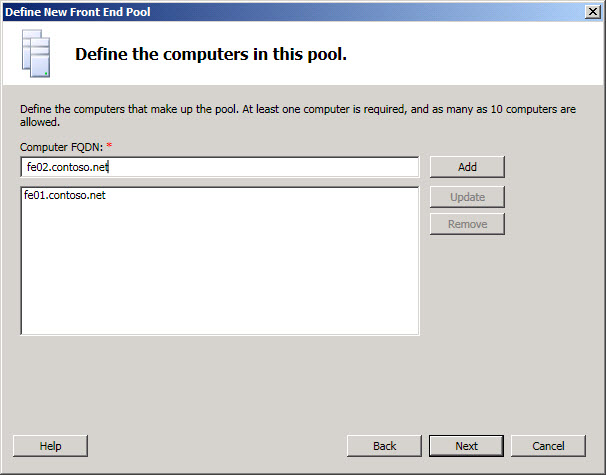
-
On the Select features page, select the check boxes for the features that you want on this Front End pool. For example, if you are deploying only instant messaging (IM) and presence features, you would select the Conferencing check box to allow multiparty IM, but would not select the Dial-in (PSTN) conferencing, Enterprise Voice, or Call Admission Control check boxes, because they represent voice, video, and collaborative conferencing features.
- Conferencing – This selection enables a rich set of
features including:
- Instant messaging (IM) with more than two parties in an IM
session
- Conferencing, which includes document collaboration,
application sharing, and desktop sharing
- A/V conferencing, which enables users to have real-time
audio/video (A/V) conferences without the need for external
services such as the Live Meeting service or a third-party audio
bridge
- Instant messaging (IM) with more than two parties in an IM
session
- Dial-in (PSTN) conferencing - Allows users to join the
audio portion of a Lync Server 2010 conference by using a public
switched telephone network (PSTN) phone without requiring an audio
conferencing provider.
- Enterprise Voice - Enterprise Voice is the Voice over IP
(VoIP) solution in Lync Server 2010 that allows users to make and
receive phone calls. You would deploy this feature if you plan to
use Lync Server 2010 for voice calls, voice mail, and other
functions that use a hardware device or a software client.
- Call admission control (CAC) – CAC determines, based on
available network bandwidth, whether to allow real-time
communications sessions such as voice or video calls to be
established. If you have deployed only IM and presence, CAC is not
needed because neither of these two features uses CAC.
 Note:
Note:If you would like to enable CAC in your deployment, it is required that you enable CAC in exactly one pool per central site. CAC is recommended if you are deploying voice features or A/V conferencing. The following table shows the available features (top) and the functions offered to users (left). The selections in the table are what you should select to enable those features for your organization.
Conferencing Dial-In Conferencing Enterprise Voice Call Admission Control Instant messaging and presence
X
Conferencing
X
X
A/V conferencing
X
X
X
Enterprise Voice
X
X
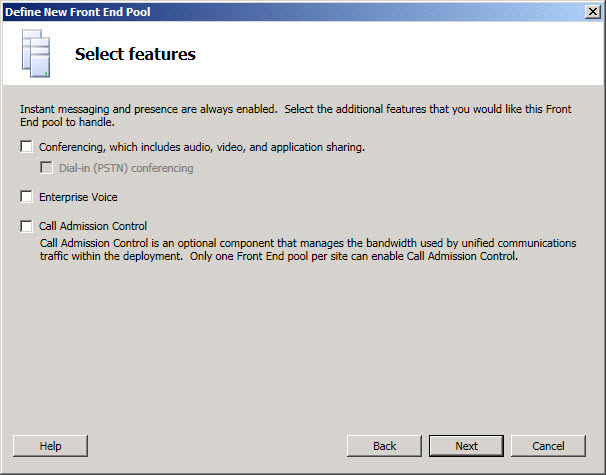
- Conferencing – This selection enables a rich set of
features including:
-
On the Select collocated server roles page, you can choose between collocating the A/V Conferencing service and the Mediation Server on the Front End Server or to deploy one or both as stand-alone servers.
 Note:
Note:If you did not select Conferencing on the Select features page, Collocate A/V Conferencing service will not be selected and will be unavailable. Conferencing is required to collocate the A/V Conferencing Server on the pool. If you plan to home less than 10,000 users on the pool, and if A/V Conferencing is not a mission critical function for your organization, we recommend collocating the A/V Conferencing service on the pool. If your requirements are greater than the 10,000 users or if you have mission critical requirements for A/V Conferencing, you can deploy stand-alone A/V Conferencing Servers or a pool of A/V Conferencing Servers associated with this Front End Server.
Like the A/V Conferencing service, you can collocate the Mediation Server on the Front End pool.
- If you intend to collocate the A/V Conferencing service or the
Mediation Server on the Enterprise Edition Front End pool, ensure
the check boxes are selected. The server roles will be deployed on
the pool servers.
- If you intend to deploy the A/V Conferencing service or the
Mediation Server as stand-alone servers, clear the appropriate
check box. You will deploy one or both of these servers in a
separate deployment step after the Front End Server is completely
deployed.
 Note:
Note:We recommend that you collocate the Mediation Server if possible. For details about support for collocated or stand-alone Mediation Servers, see Components and Topologies for Mediation Server in the Planning documentation. 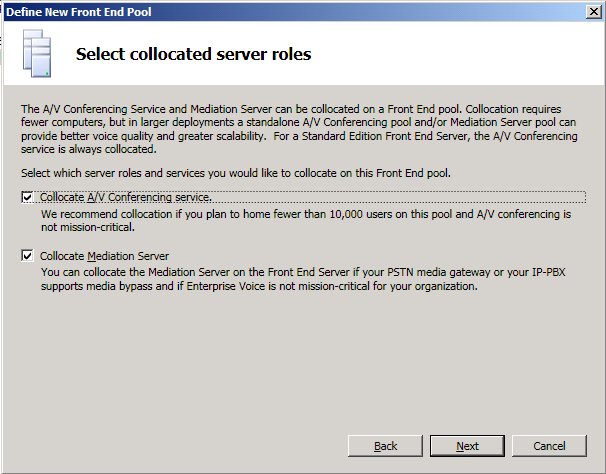
- If you intend to collocate the A/V Conferencing service or the
Mediation Server on the Enterprise Edition Front End pool, ensure
the check boxes are selected. The server roles will be deployed on
the pool servers.
-
The Associate server roles with this Front End pool page allows you to define and associate server roles with the Front End pool. The three roles that are available are:
Enable Archiving — defines and associates the Archiving Server that collects and stores messages incoming and outgoing from the organization. For example, you must monitor communications for regulatory compliance or quality assurance.
Enable Monitoring — defines and associates the Monitoring Server that collects information in the form of call detail records (CDRs) and call error records (CERs). In addition, the Monitoring Server collects data on the quality of network media for Enterprise Voice and A/V conferencing.
Enable an Edge pool — defines and associates a single Edge Server or a pool of Edge Servers. An Edge Server facilitates communication and collaboration between users inside the organization and people outside the organization, including federated users.
There are two possible scenarios that you can use to deploy and associate the server roles:
For scenario one, you are defining a new topology for a new installation. You can approach the installation in one of two ways:
- Leave all check boxes clear and proceed with defining the
topology. After you have published, configured, and tested the
Front End and Back End Server roles, you can run Topology Builder
again to add the role servers to the topology. This strategy will
allow you to test the Front End pool and SQL Server-based server
without additional complications from additional roles. After you
have completed your initial testing, you can run Topology Builder
again to select the roles you need to deploy.
- Select roles that you need to install, and then set up the
hardware to accommodate the selected roles.
For scenario two, you have an existing deployment and your infrastructure is ready for new roles or you need to associate existing roles with a new Front End Server:
- In this case, you will select the roles that you intend to
deploy or associate with the new Front End Server. In either case,
you will proceed with the definition of the roles, set up any
needed hardware, and proceed with the installation.
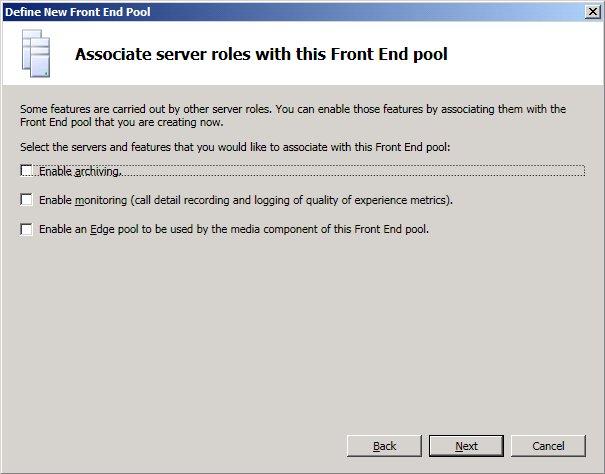
- Leave all check boxes clear and proceed with defining the
topology. After you have published, configured, and tested the
Front End and Back End Server roles, you can run Topology Builder
again to add the role servers to the topology. This strategy will
allow you to test the Front End pool and SQL Server-based server
without additional complications from additional roles. After you
have completed your initial testing, you can run Topology Builder
again to select the roles you need to deploy.
-
On the Define the SQL store page, do one of the following:
- To use an existing SQL Server store that has already been
defined in your topology, select Use a previously defined SQL
store.
- To define a new SQL Server instance to store pool information,
select Define a new SQL store, specify the SQL Server
FQDN, and then do the following:
- To specify the name of a SQL Server instance, select Named
Instance, and then specify the name of the instance.
- To use the default instance, click Default instance.
- To specify the name of a SQL Server instance, select Named
Instance, and then specify the name of the instance.
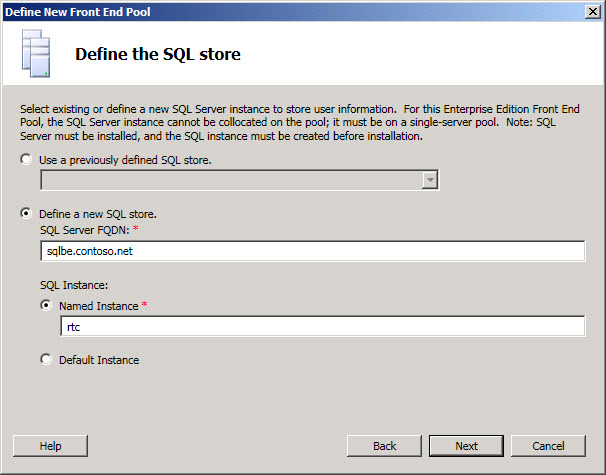
- To use an existing SQL Server store that has already been
defined in your topology, select Use a previously defined SQL
store.
-
On the Define the file share page, do one of the following:
- To use a file share that has already been defined in your
topology, select Use a previously defined file share.
- To define a new file share, select Define a new file
share, in the File Server FQDN box, enter the FQDN of
the existing file server where the file share is to reside, and
then enter a name for the file share in the File Share
box.
 Important:
Important:The file share for Lync Server 2010 cannot be located on the Front End Server. Note that in this example, the file share has been located on the SQL Server-based Back End Server. This might not be an optimal location for your organization’s requirements, and a file server might be a better choice. You can define the file share without the file share having been created. You will need to create the file share in the location you define before you publish the topology. 
- To use a file share that has already been defined in your
topology, select Use a previously defined file share.
-
On the Specify the Web Services URL page, do one or both of the following:
 Note:
Note:The base URL is the Web Services identity for the URL, minus the https://. For example, if the full URL for the Web Services of the pool is https://pool01.contoso.net, the base URL is pool01.contoso.net. - If you are configuring DNS load balancing, select the
Override internal Web Services pool FQDN check box, enter
the internal base URL (which must be different from the pool FQDN
and could be, for example, internal-<your base URL>) in
Internal Base URL.
- Optionally enter the external base URL in External Base
URL. You would enter the external base URL to differentiate it
from your internal domain naming. For example, your internal domain
is contoso.net, but your external domain name is contoso.com. You
would define the URL using the contoso.com domain name. This is
also important in the case of a reverse proxy. The external base
URL domain name would be the same as the domain name of the FQDN of
the reverse proxy. Instant messaging and presence does require HTTP
access to the Front End pool.
 Note:
Note:To use DNS load balancing, you must create the appropriate DNS records. For details, see Configure DNS for Load Balancing. 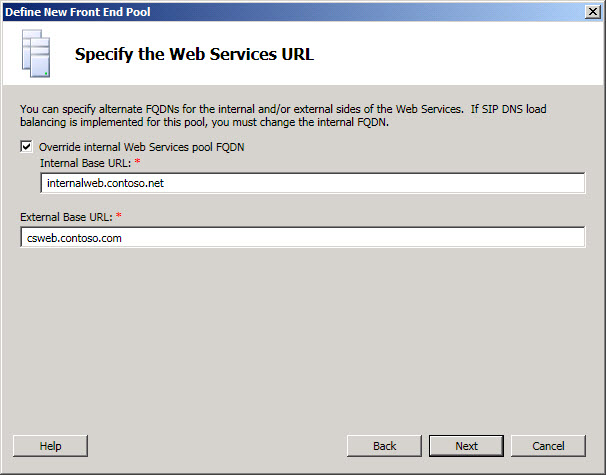
- If you are configuring DNS load balancing, select the
Override internal Web Services pool FQDN check box, enter
the internal base URL (which must be different from the pool FQDN
and could be, for example, internal-<your base URL>) in
Internal Base URL.
-
If you chose to deploy a stand-alone A/V Conferencing Server, Topology Builder will branch out to request information to configure the A/V Conferencing Server. See the topic Define a New A/V Conferencing Server, to complete the definition of the A/V Conferencing Server.
-
On the Specify PSTN gateways page, if you chose the A/V Conferencing option on the Select Features page and then selected Dial-in (PSTN) conferencing, define your planned PSTN gateways, and then click Finish to complete.
 Important:
Important:PSTN gateways need to be configured for Enterprise Voice or for Dial-In Conferencing. You can configure these later, but full functionality will be limited until the PSTN gateways are defined and configured. If you did not select Conferencing, then select Dial-in (PSTN) conferencing on the Select features page. You will not be presented with the page to Specify PSTN gateways. 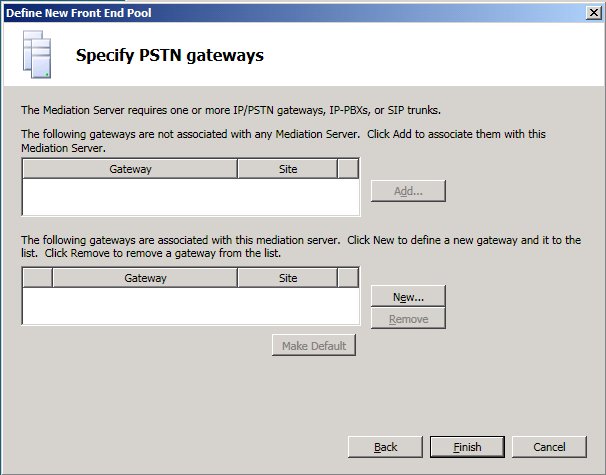
-
To define a New IP/PSTN Gateway, click New next to The following gateways are associated with this mediation server.
-
In the Gateway FQDN or IP Address, type the FQDN or the IP address of the new gateway.
-
Confirm or modify the Listening port for IP/PSTN Gateway. The default is Port 5067.
-
For SIP Transport Protocol, select TCP or TLS, based on what your infrastructure and PSTN gateway requirements are.
 Note:
Note:Not all PSTN gateways support Transport Layer Security (TLS). Check your gateway’s documentation or contact the vendor to confirm what is supported. Transmission Control Protocol (TCP) is available, but TLS is the default setting, and is recommended for its ability to encrypt the traffic from gateway to Mediation Server. 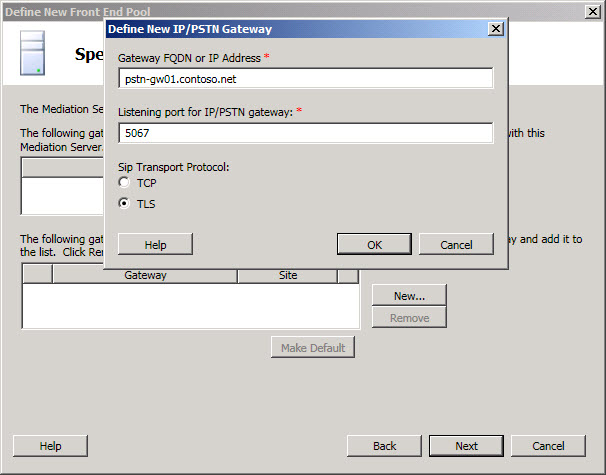
-
Click OK on the New IP/PSTN Gateway dialog box. The PSTN gateway is now listed as associated with the Mediation Server.
-
Follow the preceding steps to associate additional PSTN gateways with the Mediation Server.
-
If you have previously defined PSTN gateways, they will be listed in the The following gateways are not associated with any Mediation Server list. Click Add to associate them with this Mediation Server.
 Note:
Note:You can associate more than one PSTN gateway with a Mediation Server. However, you can associate any given PSTN gateway with only one Mediation Server. -
Click Next. If you defined other role servers on the Associate server roles with this Front End pool page, separate role configuration wizard pages will open to allow you to configure the server roles.
-
If you did not select additional server roles to configure and deploy, or when you have finished the configuration of the additional role servers, click Finish.

